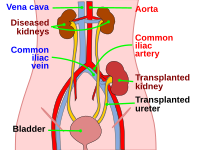
Photo from wikipedia
Split liver transplantation (SLT) is 1 strategy for maximizing the number of deceased donor liver transplants. Recent reports suggest that utilization of SLT in the United States remains low. We… Click to show full abstract
Split liver transplantation (SLT) is 1 strategy for maximizing the number of deceased donor liver transplants. Recent reports suggest that utilization of SLT in the United States remains low. We examined deceased donor offers that were ultimately split between 2010 and 2014. SLTs were categorized as “primary” and “secondary” transplants. We analyzed allocation patterns and used logistic regression to evaluate factors associated with secondary split discard. Four hundred eighteen livers were split: 54% from adult, 46% from pediatric donors. Of the 227 adult donor livers split, 61% met United Network for Organ Sharing “optimal” split criteria. A total of 770 recipients (418 primary and 352 secondary) were transplanted, indicating 16% discard. Ninety‐two percent of the 418 primary recipients were children, and 47% were accepted on the first offer. Eighty‐seven percent of the 352 secondary recipients were adults, and 7% were accepted on the first offer. Of the 352 pairs, 99% were transplanted in the same region, 36% at the same center. In logistic regression, shorter donor height was associated with secondary discard (odds ratio 0.97 per cm, 95% CI 0.94‐1.00, P = .02). SLT volume by center was not predictive of secondary discard. Current policy proposals that incentivize SLT in the United States could increase the number of transplants to children and adults.
Journal Title: American Journal of Transplantation
Year Published: 2019
Link to full text (if available)
Share on Social Media: Sign Up to like & get
recommendations!